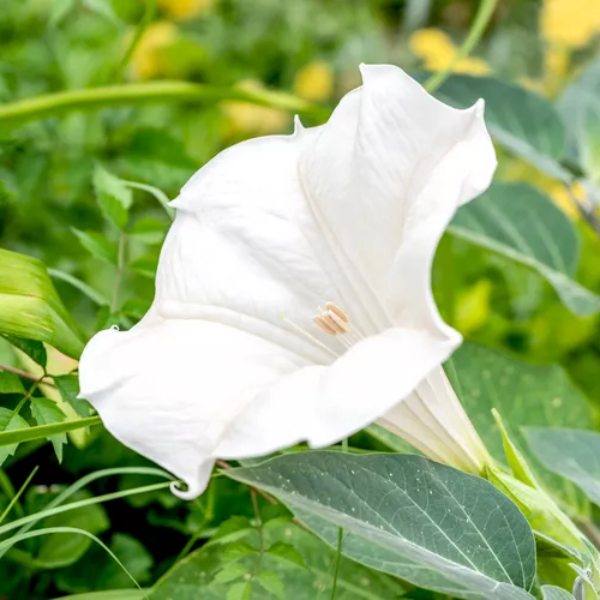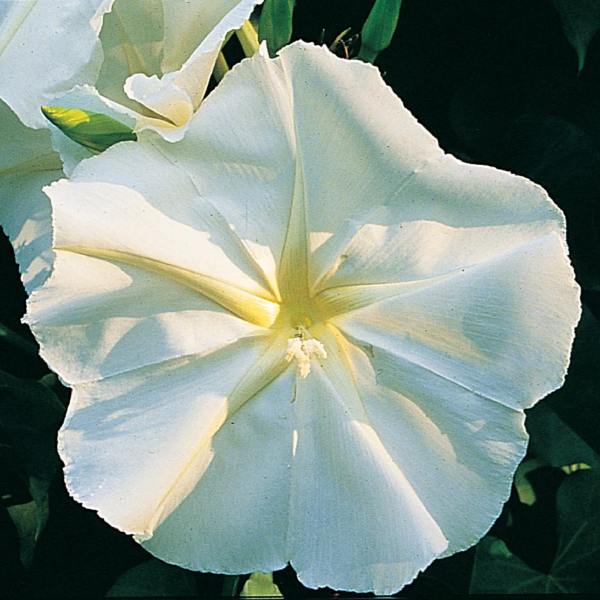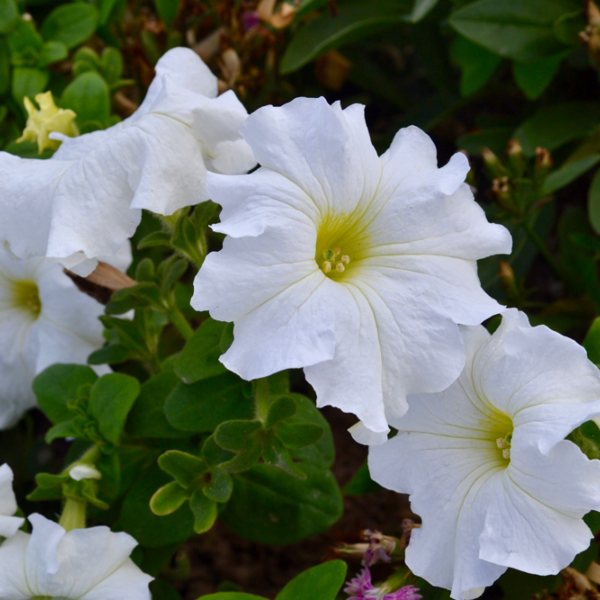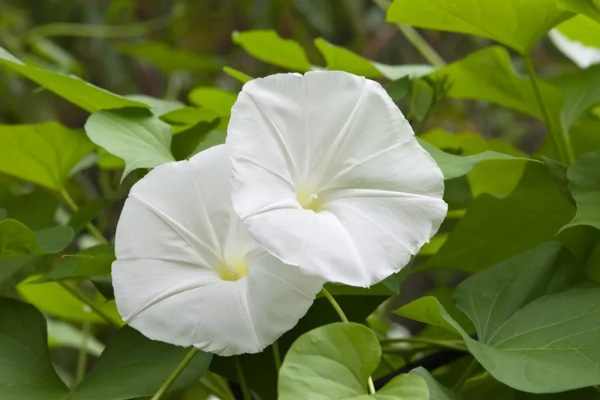Moonflowers, also known as night-blooming morning glories, are a beautiful and fragrant addition to night gardens. These tender perennial vines feature large, heart-shaped leaves, sturdy stems with slight prickles, and trumpet-shaped white flowers that open at night. Moonflowers thrive in moist, well-draining soil with slightly acidic to neutral pH. They require at least six hours of direct sunlight and temperatures above 60°F to flourish.
It’s important to note that plants in the Ipomoea genus, including moonflowers, are toxic to humans, dogs, cats, and horses. Ingestion of any part of these plants can cause serious health problems. Therefore, it’s crucial to handle moonflowers with care and keep them out of reach of children and pets.
Plant Attributes
- Common Name: Moonflowers, moon vine, tropical white or night-blooming morning glory
- Botanical Name: Ipomoea alba
- Family: Convolvulaceae
- Plant Type: Perennial, annual, vine
- Mature Size: 10–15 ft. tall, 3–6 ft. wide
- Sun Exposure: Full
- Soil Type: Moist, Well-drained
- Soil pH: Acidic, neutral
- Bloom Time: Summer, fall
- Flower Colour: White
- Native Area: North America, South America
- Toxicity: Toxic to humans, dogs, cats, and horses
How to Plant Moonflower
Moonflowers are best planted in the spring when the risk of frost has subsided. Choose a location that receives full sunlight for optimal growth and flowering. To fully appreciate the moonflower’s enchanting fragrance, consider planting it near an open window, deck, or patio.
Moonflowers can be grown in various settings, including hanging containers or as a ground cover. However, due to their vining nature, they thrive when provided with a trellis or support structure to climb. With proper care and support, moonflowers can add a touch of beauty and fragrance to your outdoor space.
Also, Read Common Mistakes Growing Papyrus Plants and How to Fix Them
How to Care for Moonflower
While moonflowers can be a beautiful addition to many gardens, it’s important to note that they are considered invasive species in Hawaii and have weed-like tendencies in subtropical regions like Florida and southern Texas. Therefore, it’s crucial to exercise caution and consider alternative plants in these areas.

If you decide to grow moonflowers in a non-invasive region, here are the main care requirements:
- Soil: Provide moist but well-draining soil with a slightly acidic to neutral pH.
- Sunlight: Ensure at least six hours of full sun per day.
- Support: A trellis or climbing structure is essential for the moonflower’s vine-like growth habit.
- Temperature: Moonflowers require warm temperatures, ideally above 60°F, to thrive.
- Fertilizer: Apply fertilizer every three to four weeks to promote healthy growth and flowering.
By following these care guidelines, you can help your moonflowers flourish and enjoy their beautiful blooms.
Light
Moonflowers are sun-loving plants that thrive in locations with at least six hours of direct sunlight per day. This abundant sunlight helps to promote vigorous growth and abundant flowering. While moonflowers can tolerate partially shaded conditions, they may not bloom as profusely or as quickly as those grown in full sun.
For optimal growth and flowering, it’s best to plant moonflowers in a location that receives ample sunlight throughout the day.
Soil
Moonflowers are adaptable plants that can tolerate different soil types. However, they prefer soil that is rich in nutrients, well-draining, and has a slightly acidic to neutral pH, ideally between 6.0 and 7.5. This type of soil provides the ideal conditions for healthy root growth and nutrient uptake, leading to vigorous growth and abundant flowering.
Water
Moonflowers prefer a moderate level of soil moisture. When watering young plants, it’s important to maintain consistently moist soil without allowing it to become soggy. Soggy soil can lead to root rot, a serious problem that can kill the plant.
Once the moonflower plant is established, water it when the top inch of soil feels dry to the touch. While moonflowers can tolerate short periods of drought, prolonged dry spells can be detrimental to their health. By providing adequate moisture without overwatering, you can help your moonflowers thrive and produce beautiful blooms.
Temperature and Humidity
Moonflowers thrive in warm, humid climates and are perennial in zones 9 to 12. If you live in a cooler region (zones 3 to 8), it’s best to wait to plant them outdoors until the temperature reaches around 60 to 70°F.

While moonflowers prefer high humidity levels, they can tolerate drier conditions if they are consistently watered. In cooler regions, moonflowers are typically annual plants, meaning they die off during cold weather.
Fertilizer
To encourage blooming, fertilize moonflowers with a high-phosphorus fertilizer every three to four weeks. Avoid using too much nitrogen fertilizer, as it can cause the plant to focus on leaf growth instead of flowers.
Types of Moonflower
- Datura inoxia, a lookalike of the moonflower, is a toxic plant in the nightshade family. It’s also known as jimsonweed or pricklyburr. While it shares similar white trumpet-shaped flowers, Datura inoxia differs in several ways: it blooms during the day, has an unpleasant odor, and has arrow-shaped leaves. Its flowers have a deeper trumpet shape with tiny spurs at the edges, and it grows more like a shrub. Datura is closely related to brugmansia.
- Moonflowers are known for their rapid growth, often reaching impressive heights of 10 to 20 feet in a single season under ideal conditions. This makes them excellent choices for covering fences, trellises, or other structures. In addition to the common moonflower (Ipomoea alba), there are several other related species with similar characteristics, such as bush moonflower (Ipomoea leptophylla) and beach moonflower (Ipomoea violacea). These moonflower varieties offer a range of options for gardeners seeking beautiful and fragrant vines for their outdoor spaces.
Pruning Moonflower
When grown as a perennial outdoors, moonflowers can be pruned back and shaped as needed in the fall to maintain their desired form and promote healthy growth. Pruning also helps to improve airflow around the plant, reducing the risk of fungal diseases and allowing for better sunlight penetration.
To prune your moonflower, carefully thin out the stems to create a more open and airy structure. This will encourage new growth and prevent overcrowding, which can hinder flowering and overall health. By regularly pruning your moonflower, you can ensure that it remains a beautiful and healthy addition to your garden throughout the year.
How to Propagate Moonflower?
Moonflowers are not easily propagated by rooting cuttings, so self-seeding is the preferred method. These plants readily drop seeds in the garden, which sprout into new plants in the spring.
To propagate moonflowers, carefully dig up the young seedlings using a garden trowel. Be gentle with the root ball as these plants don’t like being uprooted. If transplanting at the end of the growing season, pot the seedlings into peat planters and provide a support structure for the vines.
How to Grow Moonflowers from Seed?
To harvest moonflower seeds, wait for the seed pods to dry out and then collect them. You can either plant the seeds immediately or store them in a cool, dry location. If you prefer to start the seeds indoors, sow them 4-6 weeks before the last frost. Soak the seeds in warm water overnight or gently nick them to aid germination.

- After the flowers fade, collect the dry seed pods and you can plant the seeds right away or keep them in a cool, dry place.
- Sow the seeds about 4-6 weeks before the last frost and soak the seeds in warm water or lightly scratch them with a file.
- After planting the moonflower seeds, place the pot in a warm, sunny location and keep the soil slightly moist.
- Gradually introduce the seedlings to direct sunlight by spending increasing amounts of time outdoors each day.
- After a week of hardening off, transplant the seedlings into the garden.
Potting and Repotting Moonflower
Plant moonflower seedlings in potting mix, not garden soil. Avoid repotting these plants as they don’t like it. If you’re growing them upright, provide a trellis or stake for support.
Overwintering
In colder climates, moonflowers are typically grown as annuals. It’s generally easier to start new plants from seed each year rather than attempting to overwinter them indoors. After the flowers fade and the foliage begins to wither, pull the entire plant from the ground. Leaving the vines in place can lead to excessive self-seeding in the spring. To prevent uncontrolled spread, avoid adding dead plants to compost heaps.
In warmer climates where moonflowers grow as perennials, winter is an ideal time to survey the ground and remove any unwanted seedlings. This helps to manage their spread and maintain control over the plant population.
Common Pests and Diseases
Moonflowers are generally resistant to pests and diseases, but they can sometimes be affected by black rot, a bacterial disease that thrives in humid conditions. To prevent black rot, ensure that the moonflower vines have plenty of space to promote air circulation. Avoid watering the plants from overhead or at night to keep the leaves dry.
How to Get Moonflower to Bloom
Moonflower blooms open up at night on cloudy days, releasing their sweet fragrance into the air before closing in the morning.
Bloom Months
Moonflowers typically bloom from July to the first frost in summer and fall. They only bloom perennially in warm tropical areas.
What Do Moonflower Blooms Look and Smell Like?
Moonflowers are trumpet-shaped flowers with a sweet fragrance that bloom at night. They are typically white and can grow up to 6 inches long and 3-6 inches wide.
How to Encourage More Blooms
To encourage continued flowering, remove spent moonflower blooms. This will also prevent unwanted reseeding. Moonflowers need ample sunlight and regular watering to bloom reliably. Using a high-phosphorus fertilizer can help increase flower production.
Common Problems With Moonflower
Moonflowers are relatively low-maintenance plants, requiring basic care like watering and fertilizing. However, they can occasionally encounter minor issues that are easy for gardeners to address.
Yellow Lesions on the Edges of Leaves
Black rot is a bacterial disease that can cause moonflowers to lose their leaves. To prevent and treat black rot, ensure the vines have enough space and avoid overwatering, especially in the evening or from overhead.
Seedlings Die for No Reason
Damping-off is a common problem that can cause seedlings to die unexpectedly. To prevent damping-off, avoid overwatering and overcrowding seedlings. Thinning out plants and using a porous seed-starting mix can help improve air circulation and reduce the risk of fungal growth.
FAQs
Q: Does the moonflower come back every year?
Ans: Moonflowers are perennial plants in zones warmer than 45°F, meaning they return year after year without needing to be replanted. In colder zones, if moonflowers reappear, it’s likely due to seeds that were dropped from the previous season’s plants.
Q: Should I deadhead moonflowers?
Ans: Deadhead your moonflower plant to encourage continuous blooming and avoid unwanted seed pods that can lead to overgrowth.
Also, Read Learn How to Prune Trees and Plants in Your Garden!
